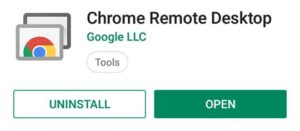Click 'Allow.' The app's main screen will then present you with two options: setting the app up for someone else to access your computer for remote assistance or setting it up for your own personal remote sign-ins. The first time you open the app, it'll ask you to grant it permission to view your computer and manage chat messages. If you're using a Chromebook, meanwhile, just look for the Chrome Remote Desktop icon in your regular app launcher.) (In the future, you can find the icon by typing chrome:apps into the browser's address bar on Windows, Mac and Linux systems - or, if you want even easier access, right-click or Ctrl-click the icon and follow the prompts to create a system-level shortcut. In Chrome, go to the Chrome Remote Desktop app in the Chrome Web Store, click the Add to Chrome button, click 'Add app,' and then click the Chrome Remote Desktop icon that appears on your screen (alongside other app icons) to launch it. Open up the Chrome browser on the computer you want to access remotely (or download and install Chrome, if you're using a Windows, Mac or Linux system that doesn't already have it). In fact, all you need to do is follow these three steps: Step 1: Install Chrome Remote Desktop on the host computer And best of all? Getting the service up and running is easy as can be.


